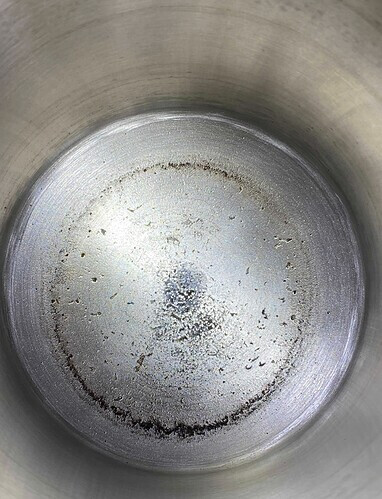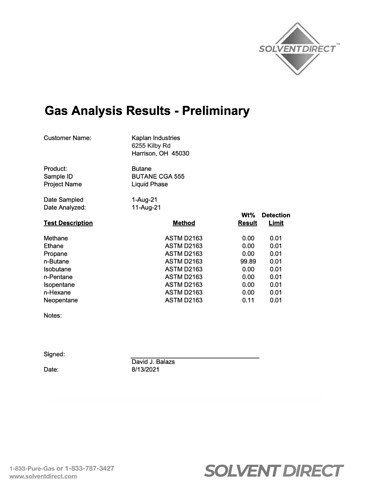They’re heptane isomers (mainly)
I personally wouldn’t consider it a failed result. Just something to be aware of given the significantly higher boiling point. Might be a dealbreaker for some depending on what they’re making but it would be negligible for a lot of things. Have you seen these show up in gases recently?
Reason I ask is I’ve been seeing residual heptanes more and more lately on various totally unrelated samples (including non-cannabis products). For the last year I keep asking to myself “what’s going on with all this heptane lately?”
4 Likes
Bringing in our conversation from the other thread. So a tank can be 80% water hypothetically, and as long as the other 20% is hydrocarbons…. That’s enough to be instrument grade gas.
Since instrument grade gas is 99.5% purity and above. What can the other .5% be if water, sulfur, filling lubricants, welding shit…. Can all be in the tank and that tank can still have a 100% COA.
I’m so confused
3 Likes
We haven’t. Just interested in improving our processes specifically for the extraction space.
My guess is those are stuck in the tank and not coming out in the sample being drawn.
2 Likes
im just a bit stumped thinking about something in this thread and how someone can explain it to me.
There are a number of 100% COAs in this thread. All gas. No heavier hydrocarbons.
For example…

These COAs shows these tests resulted in 100% gas… if this has no impurities… and the test shows no impurities…If these tanks are cleaned between EVERY FILLING
What is this??

7 Likes
Dirt and shit…
Looks like it’s been factored by 10!
3 Likes
im being serious. if the coas show 100% gas. even though only 99.5 is required… them COAs show all gas. I dont think there is a COA in this thread that doesnt equal 100% gas…
so if the tanks are being cleaned…what is that stuff??
4 Likes
Probably a function of the sampling procedure. If the coa is from a sample taken off the vapor headspace its very unlikely that it would show any of those heavy impurities regardless of their miscibility.
if this seems like cherry picking…
14 Likes
See I want all that mixed with like 10 ml of liquid tane and sent off for testing.
2 Likes
well how does it get in there if the tanks are cleaned every fill and the gas is 100% gas?
3 Likes
If I had to guess I’d say its mostly from lubrication of the pumps/filling equipment at various stages of the supply chain. Mostly at the refinery end. If you clean a tank and then spray a liquid/gas mix from a bulk iso container that has that junk in it there may be less than if you repeated the cycle multiple times without cleaning the end tank but i think we’re all in agreement that the acceptable amount of that junk is none lol. Nobody is filling these tanks by transferring gaseous solvent and the reality is that the equipment used by the refinery/transfer stations are just not sanitary/unlubricated equipment. Maybe if SD really wants to pitch the merits of their produxt they can start doing gas-phase transfers into their fucking coffee cup…
9 Likes
Now that’s an actual fucking idea there!
2 Likes
There’s about a snowballs chance in hell that they’ll do it lol, they’re going to leave that annoying and painstaking process to all of us  . Plus, if they do that and there’s still mystery oil, there are gonna be some more questions about how exactly that coffee cup gets cleaned…
. Plus, if they do that and there’s still mystery oil, there are gonna be some more questions about how exactly that coffee cup gets cleaned…
4 Likes
COA’s all add up to 100% because it’s all that’s being tested for. That’s why we’re having the discussion of whether that needs to be expanded.
For example, moisture content is not listed as part of the 100% composition, even though it may be present and listed elsewhere on the COA. Another example from our COA in your post would be sulfur content. That’s analyzed under one ASTM standard while hydrocarbon analyses is a different standard.
5 Likes
That makes no sense at all. All percentages should be percentage of total composition not percentages of what you can test for. That would be like saying every flower tests at 100% cannabinoids because that’s all I’m testing for on my hplc.
11 Likes
If you were doing an analyses of cannabinoids yes, it would add up to 100%. That’s a good example. What your COA is is an analyses of the hydrocarbons together with a listing of things that we know to test for that aren’t hydrocarbons (moisture, sulfurs, etc.).
3 Likes
Well a lot of your coas are showing no sulfur or benzene so we know it’s more than just testing hydrocarbons.
This is new news to me that the gas coas are not of the composition of the tank but just of the components of the gas.
6 Likes
Correct. We run the gas through several standards to list additional information for y’all.
Edit: ASTM D2163 isn’t going to show sulfurs without carbon that’s what a hydrocarbon analysis is.
1 Like
That’s not how my cannabinoid tests work they show me what percentage by weight that cannabinoid is. This should be fixed universally. Thanks for bringing this up @Killa12345
5 Likes
Now I’m actually wondering what different impurities can be found in these tanks
So a tank can contain 20% water and still show a 100% coa? I know this is an exaggeration but it’s theoretically true.
4 Likes


